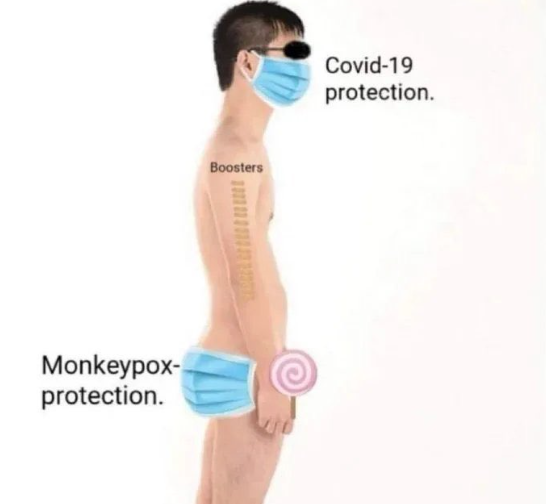Written by Stephen Collins.
In what can only be described as a bold new frontier in public health guidance, the Centers for Disease Control and Prevention (CDC) has issued an unexpected advisory: to prevent the spread of Monkeypox, it’s time to start covering your backside with paper masks. Yes, that’s right, your favorite facial accessory is now making its way south to protect an entirely different set of cheeks.
The CDC’s latest recommendation has sparked equal parts confusion and amusement across the nation. While paper masks have been hailed as the frontline defense against airborne diseases, their new role as butt protectors has left many scratching their heads—and possibly their rear ends. According to the CDC, this new measure is in response to emerging evidence that Monkeypox, a disease known for causing a rather unpleasant rash, could be transmitted through close contact, including the nether regions.
Health officials argue that the move is a proactive measure to stop the spread of Monkeypox before it becomes the next big pandemic. But for the general public, the idea of wearing a paper mask where the sun doesn’t shine has been met with a mix of skepticism and outright laughter. After all, when was the last time anyone worried about catching a disease through their derriere?
A New Fashion Statement: Paper Masks for Your Rear
As expected, the CDC’s new guidance has sparked a wave of innovative and, let’s be honest, bizarre fashion choices. Social media is already flooded with posts of people creatively affixing paper masks to their pants, skirts, and even yoga shorts. The hashtag #ButtMask has begun trending, with some users offering tutorials on the most stylish ways to secure a mask to your backside without it slipping off during your daily activities.
Entrepreneurs have jumped on the bandwagon, launching a new line of designer butt masks. These range from plain, white surgical masks to more elaborate creations featuring rhinestones, sequins, and even LED lights for those who want to add a little flair to their backside protection. Some have even started selling themed masks to match popular face mask designs, ensuring that you can be coordinated from head to, well, tail.
Yet, not everyone is on board with the idea. Critics argue that the CDC’s latest advice is nothing more than a desperate attempt to maintain relevance in a world increasingly tired of ever-changing health guidelines. They point out that while the notion of a butt mask may be amusing, it’s unlikely to have any significant impact on the spread of Monkeypox. As one skeptic put it, “If we’re at the point where we need to cover our butts with paper masks, maybe it’s time to rethink our approach to public health.”
The Science Behind the Butt Mask
In an attempt to justify this new recommendation, the CDC has rolled out a series of scientific explanations that, while technically sound, have left many scratching their heads. According to the CDC, Monkeypox can be spread through direct contact with bodily fluids, including those secreted by sores or lesions. The paper mask, they argue, acts as a barrier to prevent transmission from one person’s skin to another’s.
Health experts have pointed out that, in theory, the idea isn’t entirely far-fetched. After all, we’ve spent the last few years being told that masks are our best defense against disease. So why not extend that logic to every part of our bodies? However, others argue that this might be taking things a bit too far. While a paper mask on your face might protect you from a cough or sneeze, the likelihood of needing one on your backside seems, at best, minimal.
The CDC, however, remains steadfast in its recommendation. They insist that the paper mask serves as an additional layer of protection, particularly in situations where close contact is unavoidable. And while the public might be having a good laugh at the idea, the CDC believes that taking this step now could help prevent a much larger outbreak in the future.
Our Take
There’s no denying that the CDC’s latest recommendation has given us all a good chuckle. The idea of wearing a paper mask on your backside is undeniably humorous, and the internet’s response has only amplified the absurdity. But beneath the laughter lies a more serious issue: the erosion of trust in public health guidance. When health officials suggest measures that seem more like the punchline to a joke than a practical solution, it’s no wonder the public grows increasingly skeptical.
While we can appreciate the CDC’s efforts to be proactive in the face of a potential Monkeypox outbreak, perhaps it’s time to focus on more practical measures—ones that don’t involve turning our butts into the latest mask-wearing hotspot. After all, if the CDC continues down this path, we might soon find ourselves covering every inch of our bodies with paper masks, and that’s a reality none of us want to face—or sit on

